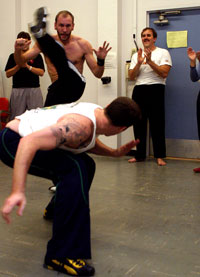Brazilian fight-dance packs a punch

Joseph Vasquez / The
Collegian
In Capoeira stretching
is important according to group instructor Jeremy Johnson pictured
sending a kick over Jacob Petway’s head. |
By Jennifer Palmberg
The Collegian
Capoeira is a sport made famous
by the movie “Only the Strong,” though it made a more recent
and less serious debut in the comedy “Meet the Fockers.”
Capoeira is part dance and part fight. It is performed to the rhythm of
the berimbau, an African string instrument and as the tempo of the beat
changes so does the tempo of the capoeirista or dance-fighter. Today the
sport is used as a game, exercise or self-defense. But originally it was
used for combat.
Fresno State club founder Jacob Petway has been practicing the sport of
Capoeira for about two years.
He was originally a member of
the Capoeira Brazil Club at Fresno City College and decided to bring the
club to Fresno State. This is the first semester the club has been offered.
“It’s more than a dance and more than a fight,” Petway
said. “It is a form of self expression. Everyone practices it differently.”
Petway said the group varies in experience from some who are just learning
and others who have been practicing the sport for six years. He said besides
the actual sport, the group learns how to sing and perform authentic Portuguese
music.
“We’ll spend one or two hours their first week teaching new
members how to play the instruments and perform the songs, but how good
they get depends on how much they want to learn,” Petway said.
“You get what you put
in to Capoeira.”
African slaves founded Capoeira as a form of self-defense.
The Dutch invaded Brazil between 1624 and 1630. During the invasion, African
slaves used the chaos as an opportunity to escape from their Brazilian
owners and take shelter in the nearby forests. They formed political communities
known as Quilombos, which were ultimately ruled by a king.
After the Dutch were expelled, the Brazilian owners organized armed expeditions
that went out to recapture fugitive slaves. With minimal weapons, the
Quilombos knew they had to defend themselves somehow using their hands
and feet. As a result, they created Capoeira.
Capoeira is a cultural art that was illegal to practice in Brazil until
about 1930. After the practice was made legal it flourished into a sport
that is practiced around the world.
This year marked the 30th anniversary of Capoeira in the United States.
To celebrate a national gathering called Batizado was held in New York.
Petway said Capoeira clubs from all over the nation joined the celebration.
“It’s a big sport that’s growing in popularity every
day,” Petway said. “Anyway you use it, it is great exercise.”
The Capoeira Brazil Club meets on Mondays and Thursdays from 6-8 p.m.
In good weather the club meets outside of McKee Fisk on the quad, in bad
weather or if it gets too dark the club practices inside McKee Fisk in
room 204, Petway said.
For more information about the club, contact Jacob Petway at 455-3865.
Comment
on this story in the Features forum >>
|
